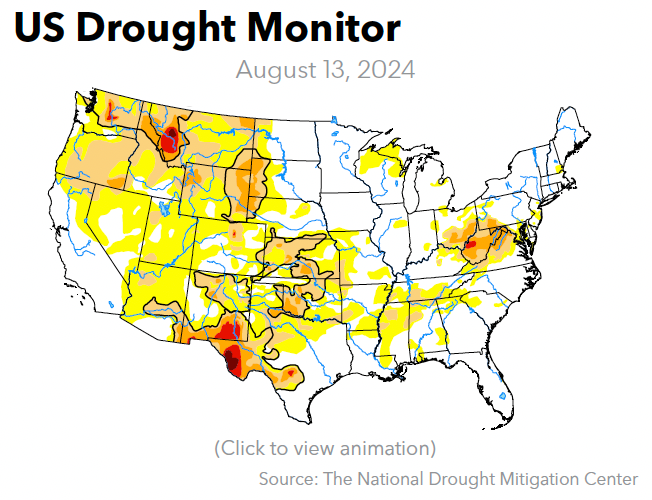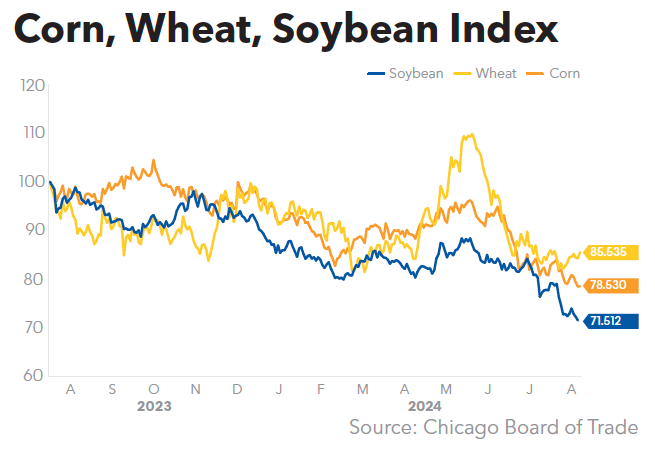Eastern Cornbelt:
Most of the Eastern Cornbelt enjoyed dry weather and comfortable temperatures in the 80s during the week, but an increased chance of storms was likely late in the week and into the weekend.
Forecasts warned of strong storms with hail and damaging winds in northern Illinois on Aug. 15-16, while the National Weather Service in Indianapolis, Ind., on Aug. 15 issued a severe weather warning for the weekend, with flash flooding possible in some locations.
Similar forecasts were in place for central and northern Ohio, with widespread rain and thunderstorms expected on Aug. 16-17 and highs topping out in the mid-80s. Severe storms were also in Michigan’s forecast on Aug. 16.
USDA on Aug. 11 rated 72-76% of the corn and soybeans in Illinois as good or excellent, along with 68-69% of the acreage in Indiana, 59-62% in Ohio, and 56-59% in Michigan.
Western Cornbelt:
Another round of heavy rain churned through western and central Iowa on Aug. 14-15, with nearly four inches reported in Winterset and more than two inches falling in locations such as Iowa City, Quad Cities, Lorimor, and Clarinda.
Multiple Nebraska locations also collected more than two inches of rain as the system pushed through the region, including Ralston, Springfield, and Omaha, while Council Bluffs and Fremont each saw more than an inch of rainfall at midweek.
The National Weather Service also warned of the potential for severe weather in central Missouri on Aug. 15, with forecasts warning of damaging winds, large hail, and possible tornadoes.
Crop conditions remained very favorable in the region, with good or excellent ratings assigned to 77-81% of the corn and soybeans in Missouri and Iowa and 69-71% in Nebraska. Missouri’s rice crop and cotton were 71% and 55% good or excellent, respectively, while 70% of Nebraska’s sorghum crop fell into those two categories at mid-month.
California:
Hot summer weather continued across California in mid-August, though the triple-digit highs of recent weeks have moderated a bit, and spotty thunderstorms were reported across Northern California.
The massive Park Fire, California’s largest wildfire so far this year and the fourth largest on record in the state, was 40% contained on Aug. 14 after scorching more than 670 square miles. A large portion of the fire is within Lassen National Forest, with major impacts reported in Butte and Tehama counties.
Other major fires in California had significant levels of containment at mid-month, except for the Aug. 9 Boise Fire in Six Rivers National Forest, which had covered more than 11 square miles by midweek.
California’s cotton crop was 100% good or excellent as of Aug. 11, with 70% of the acreage setting bolls by that date. The state’s rice crop was 95% good or excellent.
Pacific Northwest:
Temperatures moderated considerably across the Pacific Northwest in mid-August, though heavy smoke was still a factor in most locations due to numerous wildfires in the region and in western Canada.
Strong thunderstorms were reported in the Klamath Basin at midweek, with reports of gusty winds and marble-sized hail. Frequent thunderstorms also rolled through parts of Idaho and western Montana during the week, bringing brief but heavy rain to some locations.
The small grains harvest was well underway in the region. Oregon growers had 83% of the winter wheat crop in the bin by Aug. 11, compared with 69% in Montana, 66% in Washington, and 48% in Idaho. The spring wheat and barley harvest was 32-38% complete in Washington, 19-22% in Montana, and 17-19% in Idaho, with good or excellent ratings assigned to 63-79% of the acreage in Idaho, 58-59% in Montana, and just 17-21% in Washington.
Western Canada:
A strong storm on Aug. 12 brought large hail and heavy rain to parts of southern Alberta, including reports of hail damage to some crops that were nearly ready to harvest. Nearly all of the state was also under an air quality advisory in mid-August due to smoke from multiple wildfires in the region.
Manitoba growers had 17% of the winter wheat crop and 39% of the fall rye harvested by Aug. 13, with combining also underway on barley, field peas, and spring wheat. Harvest progress was tracking slightly ahead of the average pace in Saskatchewan, with 6% of all crops in the bin across the province and up to 16% in southwestern Saskatchewan.
Alberta growers are expecting an average crop this year after hot, dry weather in July. Currently 51% of all crops in the province are rated as good or excellent, below the five- and ten-year averages of 56% and 59%, respectively.

